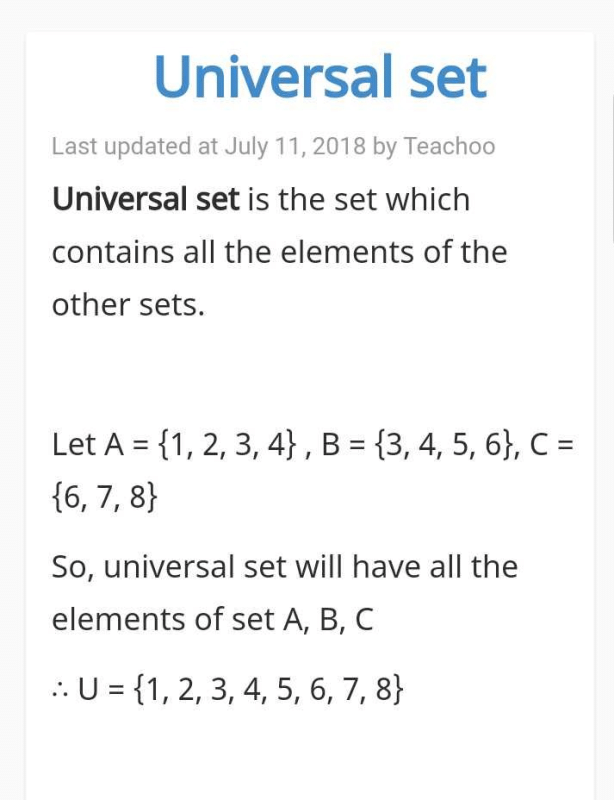JEE Exam > JEE Questions > Define universal set with examples.?
Start Learning for Free
Define universal set with examples.?
Most Upvoted Answer
Define universal set with examples.?

Community Answer
Define universal set with examples.?
What is a Universal Set?
A universal set is a set that contains all possible elements or objects within a given context or problem. It is the largest set that can be considered in a particular situation. The universal set is typically denoted by the symbol 'U'.
Examples of Universal Sets
- The set of all whole numbers: This includes all positive integers, negative integers, and zero.
- The set of all real numbers: This includes all numbers that can be expressed as a decimal, whether they are rational or irrational.
- The set of all possible outcomes in a coin toss: This includes both heads and tails.
- The set of all possible outcomes when rolling a dice: This includes the numbers 1 through 6.
- The set of all possible combinations of letters in the English alphabet: This includes all possible arrangements of the 26 letters of the alphabet.
Uses of Universal Set
The concept of a universal set is used in set theory and other branches of mathematics. It allows us to define subsets and complement sets, which are important concepts in solving mathematical problems.
For example, if we have a set A that is a subset of a universal set U, we can define the complement of A as the set of all elements in U that are not in A. This is denoted by A'.
Furthermore, the concept of a universal set allows us to perform operations such as union and intersection of sets. The union of two sets A and B is the set of all elements that are either in A or in B. The intersection of two sets A and B is the set of all elements that are in both A and B.
Conclusion
The universal set is an important concept in mathematics and is used in various fields such as probability, statistics, and logic. It provides a framework for defining subsets and performing operations on sets, which are essential tools in solving mathematical problems.

|
Explore Courses for JEE exam
|

|
Similar JEE Doubts
Question Description
Define universal set with examples.? for JEE 2025 is part of JEE preparation. The Question and answers have been prepared according to the JEE exam syllabus. Information about Define universal set with examples.? covers all topics & solutions for JEE 2025 Exam. Find important definitions, questions, meanings, examples, exercises and tests below for Define universal set with examples.?.
Define universal set with examples.? for JEE 2025 is part of JEE preparation. The Question and answers have been prepared according to the JEE exam syllabus. Information about Define universal set with examples.? covers all topics & solutions for JEE 2025 Exam. Find important definitions, questions, meanings, examples, exercises and tests below for Define universal set with examples.?.
Solutions for Define universal set with examples.? in English & in Hindi are available as part of our courses for JEE.
Download more important topics, notes, lectures and mock test series for JEE Exam by signing up for free.
Here you can find the meaning of Define universal set with examples.? defined & explained in the simplest way possible. Besides giving the explanation of
Define universal set with examples.?, a detailed solution for Define universal set with examples.? has been provided alongside types of Define universal set with examples.? theory, EduRev gives you an
ample number of questions to practice Define universal set with examples.? tests, examples and also practice JEE tests.

|
Explore Courses for JEE exam
|

|
Signup to solve all Doubts
Signup to see your scores go up within 7 days! Learn & Practice with 1000+ FREE Notes, Videos & Tests.





















